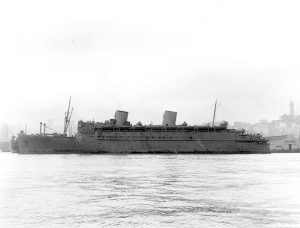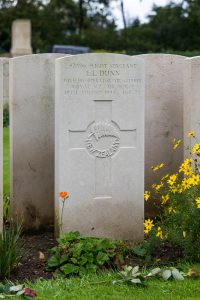I have already made a brief reference to Patrick’s son-in-law Ernest Leslie Dunn. (see VE Day: Patrick’s perspective) The days leading up to Remembrance Sunday made me investigate his story in more detail.
The service records always refer to him as Leslie Dunn. There is no one left that can tell me whether he was normally called by that name. I suspect that he chose to use his second name. His father was Edward Dunn. Two men called E Dunn may have been seen to be confusing. I will refer to him as Les to avoid having to write out the full name every time. He came from farming stock in the Whakapara region in the northern half of New Zealand’s North Island. He enlisted in March 1942, initially in the Army, at the age of 21. This started a very long journey that was to take him half way round the world but was, sadly, to end in northern France.
He volunteered to be transferred to the Air Force and undertook initial training at Rotorua.
He left Wellington on 29th May in the SS Matsonia (pictured), a 17,000 ton requisitioned cruise ship, heading for San Francisco (8,300 miles away) where he arrived on 11th June.  The arrival record tells us that he was 5’ 8” tall with a fair complexion and blue eyes. The next stop was to undertake more basic training at 3 M Depot in Edmonton, Alberta, 1500 miles away.
The arrival record tells us that he was 5’ 8” tall with a fair complexion and blue eyes. The next stop was to undertake more basic training at 3 M Depot in Edmonton, Alberta, 1500 miles away.
His health seems to have been an issue. He spent the first nine days in hospital when he arrived in Edmonton. Later spells, totalling seven weeks, were to follow.
Wireless School was undertaken in Calgary Alberta, another 180 miles away. This was followed by Bomb & Gunnery School at Mountain View Ontario, a mere 2,250 miles distant.
By May 1943 Leslie had been promoted to Sergeant and was based at an Operational Training Unit at Pennfield Bridge, New Brunswick. The outline of the base can still be seen on Google maps. (Another 1050 miles of travelling.)
The last stop on his Canadian sojourn was an Embarkation Depot at Halifax, Nova Scotia. (300 miles) He left Canada on 24th November 1943, arriving in England on 2nd December (3,300 miles). I assume that the port of entry was Liverpool because he was taken to a Receiving Centre in Warrington. This is only 20 miles from Liverpool. A few short trips within England took his total distance travelled since leaving New Zealand to well over 16,000 miles.
Further training took place including time on Mitchell Bombers at 13 Operational Training Unit, based at Bicester, 60 miles north west of London.
He finally joined 226 Squadron on 20th July 1944. They were based at RAF Hartford Bridge, now better known as Blackbushe Airport, south west of London. He flew 16 missions (another source calculates 14) and was killed on 19th August. That is 28 months of training, a journey more than half the way around the world and only one month of operational service.
The plane was hit by anti-aircraft fire. It crashed near the small village of Tordouet, in the Calvados region. The five crew members were initially buried close to the crash site. Subsequently they were all reinterred in official war cemeteries. Four of them were buried at Bretteville-sur-Laize Canadian Cemetery, SSW of Caen. Leslie Dunn’s final resting place is Dieppe Canadian Cemetery at Hautot-sur-Mer. 
(Photo copyright New Zealand War Graves Trust) This is approximately 140 miles from the others. The reasons for the separation are not clear. Some Mitchell bombers operated with a crew of four, others with five. Perhaps the team handling the reburials only expected to find four graves. A subsequent search through the records, maybe months later, revealed that they had missed one.
The Squadron records show that three of the downed crew, including Les Dunn, apparently flew with another pilot four days later. It appears that their administration left something to be desired.
Telegrams announcing that Leslie Dunn was missing in action would have gone to his wife, Kathleen, in Brighton and his parents in New Zealand.
